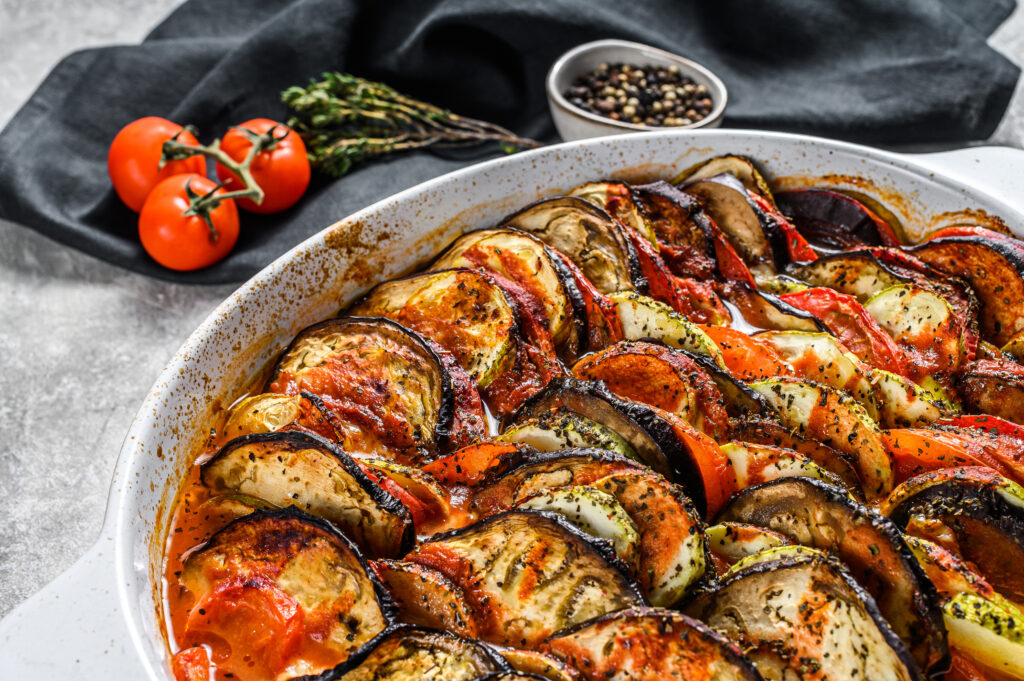Spice Blends, Uncategorized
How Ratatouille Made Its Way from Paris to Hollywood.
Chances are that if you asked anyone under the age of 21 what ratatouille is, the likely answer would be a movie. And the image that would likely come to mind wouldn’t be that of a classic French vegetable casserole.
But rather…
A Rat.

While ratatouille was already a classic in the culinary world, it was made famous once again by the 2007 Walt Disney and Pixtar Animation Studios release of the film Ratatouille, featuring an oh-so-cute rat named Remy, whose culinary “chops” go well beyond the meat locker.

Where did it all begin?
Pronounced (RAT-a-TOO-ee), it’s a French peasant dish believed to have originated in either Nice or Provencal France somewhere around the late 1700’s in a form you wouldn’t recognize today.
Back in those days, being a rural, peasant dish, ratatouille wasn’t that popular and had many versions, some more broth-like, some containing meat, if any was available. Some versions also contained beans and potatoes.
The etymology (history) of the core of the word ratatouille goes back to an expressive verb from the southern Provencal region of France that basically means “to stir up or shake.”
Later, in the 18th century, the word was used in relationship to a coarse stew, which even later became a stew of coarsely chopped summer vegetables we generally use to make this dish.
Today, ratatouille is made of stewed vegetables which features eggplant, bell pepper, squash and tomatoes with other assorted “characters” depending on the region and the whim of the chef. The choice of seasoning herbs, are, what else? Herbs de Provence.
It’s a comfort dish, and when dusted with a bit of cheese and served with crusty sliced of a freshly baked Baguette, you could almost be likened it to a French version of Cream of Tomato Soup with a Grilled Cheese sandwich.
Simple but sacred.
When prepared in the best of restaurants, ratatouille is a dish prepared with great reverence, treating each vegetable with care to be sure it is fully tasted and appreciated on its own and not melded into an indistinguishable mush.
There are 2 school of thought on its traditional preparation method.
- Add each ingredient, in steps, one after another, into one common pot.
- Cooking each ingredient separately, then combining in the pot.
Whichever method is used, one common goal is to allow each vegetable to shine on its own while still contributing some of its flavor to the combined dish. To that end, the classic ratatouille is generally only cooked for less than 30 minutes.
What about the Pixtar version of ratatouille?
Well, rats being rats, Remy cleverly “borrowed” his modern adaptation of this classic “stew”, which had already created by 2 of the world’s renowned Chef’s well before the movie was made in 2007.
First attributed to French Chef Michel Guerard, and featured in his 1976 book Cuisine Minceur, Chef Guerard made ratatouille in the “lighter style” of the cuisine that his book focused on, by shingling thin slices of its usual vegetables in a casserole dish, then baking them gently.

His recipe, Confit Bayaldi, was then, once more, in 1999, recreated by American Chef Thomas Keller who added two additional sauces, one beneath and one on top to complete the dish you both see in the movie, and when the mood strikes, in his California restaurant, The French Laundry.
Not surprisingly, Chef Keller also served as a food consultant for the movie Ratatouille, and was not only instrumental in the film’s kitchen authenticity, but in how the film would portray that iconic dish and how it would be plated.
How is it usually prepared and served?
Unlike the movie however, ratatouille is most often made using diced vegetables and gently stewed in a shallow pot rather than being baked in a casserole dish.

It’s typically served hot as entrée but it can also be served as an accompaniment side dish or even served cold, much like a similar dish, eggplant caponata.
It is also often accompanied by freshly baked bread.




